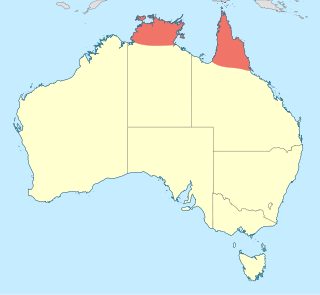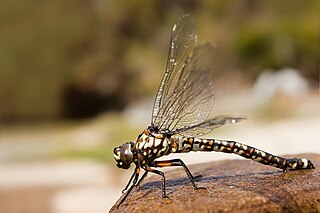
The insect family Aeshnidae, sometimes called aeshnids, comprises the hawkers. They are the largest dragonflies found in North America and Europe and are among the largest dragonflies on the planet. This family represents also the fastest flying dragonflies of the order of the dragonflies and damselflies (Odonata).

Aciagrion is a genus of damselfly in the family Coenagrionidae. Aciagrion are small and slender damselflies with a small head. They are found at still waters including swamps. Aciagrion is widely distributed in the tropics from Africa, through Indonesia to Australia. They are commonly known as Slims.

Agriocnemis is a genus of damselfly in the family Coenagrionidae. Agriocnemis is distributed widely across Africa, South-east Asia, Indonesia, Australia and islands in the Pacific. They are small insects, commonly known as wisps.

Anaciaeschna is a genus of dragonflies in the family Aeshnidae. Species of Anaciaeschna are found in Africa, Asia and Australia.
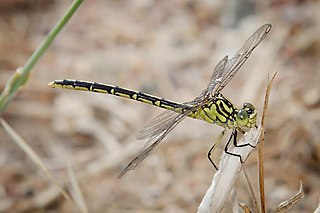
Austrogomphus is a genus of dragonflies in the family Gomphidae, endemic to Australia. Species of Austrogomphus are tiny to medium-sized dragonflies, black in colour with yellowish markings. They are commonly known as hunters.
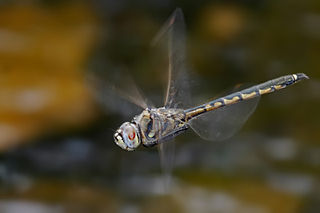
Hemicordulia is a genus of dragonfly in family Corduliidae. It occurs in Africa, southern Asia, and Australasia. Species of Hemicordulia are small to medium-sized dragonflies, coloured black or metallic, with yellow.
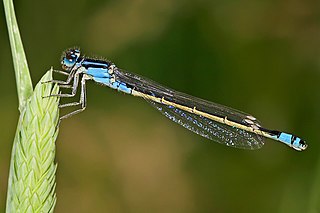
Ischnura is a genus of damselflies known as forktails in the family Coenagrionidae. Forktails are distributed worldwide, including various oceanic islands. The males have a forked projection at the tip of the abdomen which gives the group their common name.

Macromia is a genus of large dragonflies in the family Macromiidae. They are commonly known as river cruisers from their habit of cruising long distances along river banks. Most species of Macromia occur in the tropical Australasian region, with one species being found in Europe , and a few species occurring in North America.

Pseudagrion is the largest genus of damselfly in the family Coenagrionidae, with over 140 species. Its range includes most of Africa, much of Asia, and Australia. Africa holds most of the diversity with almost 100 species. It has occupied most of the freshwater habitats in its range, and dominates damselfly communities in habitats as different as desert pools, equatorial rainforests and montane streams.

Rhyothemis is a genus of dragonfly in the family Libellulidae. They are commonly known as Flutterers. Rhyothemis species are found in Africa, Asia, Australia and the Pacific region.
Teinobasis is a genus of damselflies in the family Coenagrionidae. Species occur in south-eastern Asia, Indonesia, Solomon Islands and Micronesia; one species, Teinobasis rufithorax, is found in Australia.

Tramea is a genus of dragonflies in the family Libellulidae, the skimmers and perchers. Species of Tramea are found in tropical and subtropical regions around the globe. They typically have colored bases to their otherwise translucent hindwings. In particular when they fly, this creates the impression of their carrying bags at the start of their abdomens. They are known commonly as saddlebags or saddlebags gliders.
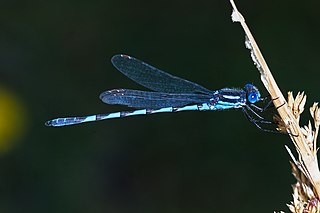
Austrolestes is a genus of medium to large-sized damselflies in the family Lestidae. Austrolestes dragonflies sit with their wings folded completely back. Males are usually bright blue and black, the females duller. Members of this genus are found in Australia, New Zealand and South Pacific islands.

Rhadinosticta is a genus of damselfly in the family Isostictidae. It is endemic to eastern Australia. Species of Rhadinosticta are slender, medium-sized damselflies, with a dull colouring.

Austroargiolestes is a genus of damselflies in the subfamily Argiolestinae of the family Megapodagrionidae. They are commonly known as Flatwings; unlike many other damselflies, at rest their wings are spread out flat.

Nannophlebia is a genus of dragonfly in the family Libellulidae. They are commonly known as Archtails. The species are very small with black and yellow striped abdomens.
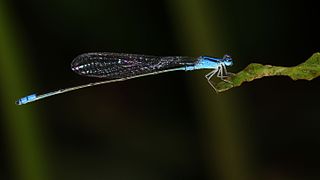
Archibasis is a genus of damselflies belonging to the family Coenagrionidae. These damselflies are generally medium-sized with bright colouring. Archibasis occurs in southern Asia, Indonesia, New Guinea and Australia.

Austroagrion is a genus of damselflies belonging to the family Coenagrionidae. Species of Austroagrion are small dragonflies; males are black with blue or green markings while females are paler. Austroagrion occurs in Papua New Guinea, New Caledonia and Australia.
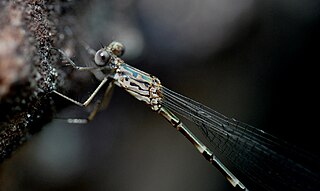
Indolestes obiri is a species of damselfly in the family Lestidae, commonly known as a cave reedling. It is endemic to Arnhem Land, in Northern Territory, Australia, where it inhabits shallow, rocky pools.


